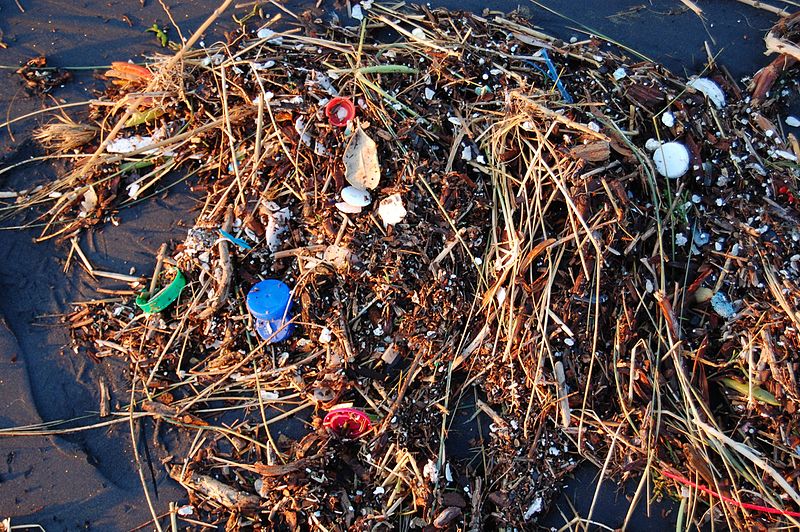
By MIRIAM ACZEL
Plastic — Not Fantastic
Plastic is the most common type of marine debris found in our planet’s ocean and lakes. Plastic debris can come in a wide range shapes and sizes, but debris that are less than five millimeters in length (roughly the size of a sesame seed) are classed as “microplastics.” Microplastics can come from many different sources, including from larger pieces of debris that has broken down into smaller pieces. Another type of mkcroplastic, microbeads, are tiny pieces of polyethylene plastic that are added as exfoliating beads to to common beauty products like soaps, toothpastes, and facial scrubs. Because of their minute size, microplastics can easily pass through water filtration systems and end up collecting in oceans, lakes, and other water bodies, where they harm aquatic life and human and animal health.
So how much plastic is in our oceans?
Alarmingly, a new study published in Limnology and Oceanography Letters showed that amount of microplastic found in our ocean is one million times greater than the amount previously estimated.
According to the authors of the paper, this means that the concentrations of microplastics polluting our oceans is not merely two or three times more than scientists had previously estimated, but rather over five to seven times greater. As plastic decomposes, it breaks into smaller and smaller pieces but never fully disappears. ,According to lead author Jennifer Brandon from the Scripps Institution of Oceanography at University of California, San Diego, “We realized that it was out there, but it’s just smaller than we were capturing.” Brandon further added that “for years we’ve been doing microplastics studies the same way (by) using a net to collect samples…But anything smaller than that net mesh has been escaping.” Brandon explained that “I saw these published size ranges and thought, we are under-sampling this smaller range. There’s a big knowledge gap.”
To get a more accurate estimate for the amount of microplastics in the ocean, Brandon and her colleagues developed a new technique for measuring the volume of mini-microplastics that were being overlooked previous studies. The researchers collected both seawater samples and salps–a kind of plankton that filter-feeds on tiny particles of food the same size as microplastics. The researchers sampled surface seawater and salps specimens collected from three distinct areas: the region within the California Current closest to the shore, the Great Pacific Garbage Patch, and an intermediate, open ocean area. Interestingly, they found that the both the surface seawater samples and the salps collected closest to shore contained significantly more plastic than those in the Great Pacific Garbage Patch. In order to identify microplastic material in both the salps and in seawater, the scientists used a special fluorescent fluorescent microscope. Importantly, plastic material ‘self-illuminates’ when it is exposed to multiple wavelengths of light, which means that it can be easily seen under a microscope.
So why is this so important?
Plastic material from a a salp’s stomach can travel up the food chain to the animals that eat salps, such as sea turtles and King Crab, among others, and eventually make their way into humans’ bodies. According to one estimate, the average person now over 50,000 pieces of microplastic a year–but likely even more. Other studies have shown that plastics bioaccumulate, and also travel up the food chain to organisms. Further studies have shown that microplastics are linked to brain damage, behavior changes, and liver tumors among other impacts in fish. While additional studies are currently underway, there are still many uncertainties and gaps in our knowledge about the impacts and risks of marine microplastics.
And although many great initiatives like the Ocean Cleanup are working to collect larger plastic debris from the ocean before they are able to decompose into microplastics, we don’t yet a way to clean up the smallest plastic particles. And while further research on microplastic removal technologies is crucial, it is particularly important to ensure that we prevent plastic pollution from entering the ocean in the first place. According to Brandon, “I think investing at the prevention level right now is the best bang for your buck, and then figuring out the next wave of the technology we’re going to use to take these tiny things out of the ocean.
Miriam Aczel is a President’s Scholar PhD Candidate at Imperial College London’s Centre for Environmental Policy. Her research focus is on international energy science and policy, with a focus on mitigation of environmental and health impacts of shale gas. She is also co-founder and co-director of the Amir D. Aczel Foundation for Research and Education in Science and Mathematics, a nonprofit based in Cambodia.
Miriam is Director of Communications and blog editor for Leaders in Energy.



Leave a Reply